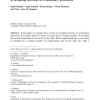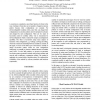79 search results - page 8 / 16 » Equivalent Number of Degrees of Freedom for Neural Networks |
NC
2011
12 years 10 months ago
2011
In this paper we consider three variants of accepting networks of evolutionary processors. It is known that two of them are equivalent to Turing machines. We propose here a direct ...
IPPS
2010
IEEE
13 years 5 months ago
2010
IEEE
Recently, there has been strong interest in large-scale simulations of biological spiking neural networks (SNN) to model the human brain mechanisms and capture its inference capabi...
GLOBECOM
2009
IEEE
14 years 2 months ago
2009
IEEE
—The degrees of freedom (DoF) of K-user MIMO interference networks with constant channel coefficients are not known in general. Determining the feasibility of a linear interfere...
IWANN
2009
Springer
14 years 1 months ago
2009
Springer
Controlling a biped robot with several degrees of freedom is a challenging task that takes the attention of several researchers in the fields of biology, physics, electronics, com...
ICRA
2003
IEEE
14 years 20 days ago
2003
IEEE
Locomotion is considered as most basic function of robots. In the case of ordinary robots, they are not needed to change locomotion pattern because their configurations are consta...


